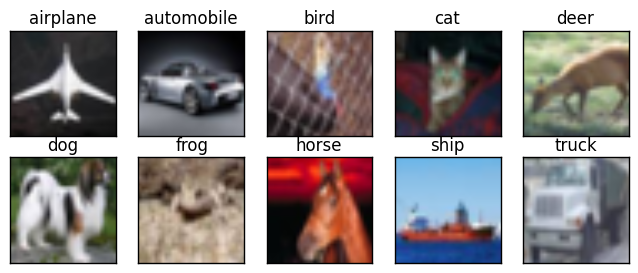learning curves
of kernel methods
- Learn from examples: how many are needed?
- We consider regression (fitting functions)
- We study (synthetic) Gaussian random data and real data
supervised deep learning
- Performance is evaluated through the generalization error \(\epsilon\)
- Learning curves decay with number of examples \(n\), often as
- \(\beta\) depends on the dataset and on the algorithm
Deep networks: \(\beta\sim 0.07\)-\(0.35\) [Hestness et al. 2017]
learning curves
\(\epsilon\sim n^{-\beta}\)
We lack a theory for \(\beta\) for deep networks!
-
Performance increases with overparametrization
\(\longrightarrow\) study the infinite-width limit!
[Jacot et al. 2018]
What are the learning curves of kernels like?
link with kernel learning

(next slides)
\(h\)

[Neyshabur et al. 2017, 2018, Advani and Saxe 2017]
[Spigler et al. 2018, Geiger et al. 2019, Belkin et al. 2019]
\(h\)
\(\epsilon\)
-
With a specific scaling, infinite-width limit \(\to\) kernel learning
[Rotskoff and Vanden-Eijnden 2018, Mei et al. 2017, Jacot et al. 2018, Chizat and Bach 2018, ...]
Neural Tangent Kernel
-
Very brief introduction to kernel methods and real data
- Gaussian data: Teacher-Student regression
- Smoothness of Gaussian data
- Effective dimension and effective smoothness in real data
outline
- Kernel methods learn non-linear functions
- Map data to a feature space, where the problem is linear
data \(\underline{x} \longrightarrow \underline{\phi}(\underline{x}) \longrightarrow \) use linear combination of features
only scalar products are needed:
\(\underline{\phi}(\underline{x})\)
kernel methods
kernel \(K(\underline{x},\underline{x}^\prime)\)
\(\rightarrow\)

Gaussian:
Laplace:
-
Target function \(\underline{x}_\mu \to Z(\underline{x}_\mu),\ \ \mu=1,\dots,n\)
- Build an estimator \(\hat{Z}_K(\underline{x}) = \sum_{\mu=1}^n c_\mu K(\underline{x}_\mu,\underline{x})\)
- Minimize training MSE \(= \frac1n \sum_{\mu=1}^n \left[ \hat{Z}_K(\underline{x}_\mu) - Z(\underline{x}_\mu) \right]^2\)
- Estimate the generalization error \(\epsilon = \mathbb{E}_{\underline{x}} \left[ \hat{Z}_K(\underline{x}) - Z(\underline{x}) \right]^2\)
kernel regression
Regression: performance depends on the target function!
-
With the weakest hypotheses, \(\beta=\frac1d\)
-
With strong smoothness assumptions, \(\beta\geq\frac12\) is independent of \(d\)
Curse of dimensionality!
[Luxburg and Bousquet 2004]
[Smola et al. 1998, Rudi and Rosasco 2017, Bach 2017]
previous works
\(d\) = dimension of the input space
\(\longrightarrow\)
real data
MNIST
CIFAR10


2 classes: even/odd
70000 28x28 b/w pictures
2 classes: first 5/last 5
60000 32x32 RGB pictures
Kernel regression on:
dimension \(d = 784\)
dimension \(d = 3072\)
- Same exponent for Gaussian and Laplace kernel
- MNIST and CIFAR10 display exponents \(\beta\gg\frac1d\) but \(<\frac12\)
real data: exponents
\(\beta\approx0.37\)
\(\beta\approx0.08\)

- Controlled setting: Teacher-Student regression
- Training data are sampled from a Gaussian Process:
\(Z_T(\underline{x}_1),\dots,Z_T(\underline{x}_n)\ \sim\ \mathcal{N}(0, K_T)\)
\(\underline{x}_\mu\) are random on a \(d\)-dim hypersphere
- Regression is done with another kernel \(K_S\)
kernel teacher-student framework
\(\mathbb{E} Z_T(\underline{x}_\mu) = 0\)
\(\mathbb{E} Z_T(\underline{x}_\mu) Z_T(\underline{x}_\nu) = K_T(|\!|\underline{x}_\mu-\underline{x}_\nu|\!|)\)
(artificial, synthetic data)
teacher-student: simulations

Generalization error
Exponent \(-\beta\)

Can we understand these curves?
teacher-student: regression
where
Compute the generalization error \(\epsilon\) and how it scales with \(n\)
kernel overlap
Gram matrix
training data
Explicit solution:
Regression:
\(\hat{Z}_S(\underline{x}) = \sum_{\mu=1}^n c_\mu K_S(\underline{x}_\mu,\underline{x})\)
Minimize \(= \frac1n \sum_{\mu=1}^n \left[ \hat{Z}_S(\underline{x}_\mu) - Z_T(\underline{x}_\mu) \right]^2\)
teacher-student: theorem (1/2)
To compute the generalization error:
- We look at the problem in the frequency domain
- We assume that \(\tilde{K}_S(\underline{w}) \sim |\!|\underline{w}|\!|^{-\alpha_S}\) and \(\tilde{K}_T(\underline{w}) \sim |\!|\underline{w}|\!|^{-\alpha_T}\) as\(|\!|\underline{w}|\!|\to\infty\)
- SIMPLIFYING ASSUMPTION: We take the \(n\) points \(\underline{x}_\mu\) on a regular \(d\)-dim lattice!
Then we can show that
with
E.g. Laplace has \(\alpha=d+1\) and Gaussian has \(\alpha=\infty\)
(details: arXiv:1905.10843)
for \(n\gg1\)
teacher-student: theorem (2/2)
- Large \(\alpha \rightarrow\) fast decay at high freq \(\rightarrow\) indifference to local details
- \(\alpha_T\) is intrinsic to the data (T), \(\alpha_S\) depends on the algorithm (S)
- If \(\alpha_S\) is large enough, \(\beta\) takes the largest possible value \(\frac{\alpha_T - d}{d}\)
- As soon as \(\alpha_S\) is small enough, \(\beta=\frac{2\alpha_S}d\)
(optimal learning)
- If Teacher=Student=Laplace
- If Teacher=Gaussian, Student=Laplace
What is the prediction for our simulations?
(curse of dimensionality!)
(\(\alpha_T=\alpha_S=d+1\))
(\(\alpha_T=\infty, \alpha_S=d+1\))
teacher-student: comparison (1/2)

Exponent \(-\beta\)
- Our result matches the numerical simulations
- There are finite size effects (small \(n\))
(on hypersphere)
TEACHER-STUDENT: COMPARISON (2/2)
Same result with points on regular lattice or random hypersphere?
What matters is how nearest-neighbor distance \(\delta\) scales with \(n\)
nearest-neighbor distance

In both cases \(\delta\sim n^{\frac1d}\)
Finite size effects: asymptotic scaling only when \(n\) is large enough
(conjecture)
smoothness
- For Gaussian data, \(\alpha_T-d \equiv 2s\) is a measure of smoothness \(\sim\) # of continuous derivatives
- Can we say something about real data?
what about real data?
1. Effective dimension is much smaller:


\(\delta\sim n^{\frac1{d_\mathrm{eff}}}\)
2. We find the same exponent regardless of the student:
Assuming this formula holds
kernel pca
- \(\mathbb{K}_S\) is the Gram matrix, \(\lambda_1\geq\lambda_2\geq\dots\) are its eigenvalues,
\((\underline{\phi}_\rho)_{\rho\geq1}\) are its eigenvectors
- Given a Teacher Gaussian process \(\underline{Z}_T\), we can project it on this basis to compute
- \(q_\rho\) is a Gaussian variable, with
Guess: measure \(\alpha_T\) in real data from this projetion!
\(\frac{\alpha_T}d = 1 + \frac{2s}d\)
\(= 1+\frac1d\,\) for Laplace
\(=1\) for Gaussian


projection of real data

Measure effective smoothness in real data
Fit \(c=\frac{\alpha_T}d\) from the projection
\(q_\rho^2\)
exponent of real data (1/3)
- We can then try and predict the exponent \(\beta\) and the smoothness!
- Smoothness \(2s = \alpha_T-d_\mathrm{eff} = d_\mathrm{eff}(c-1)\)
- Exponent \(\beta=\frac{\alpha_T-d_\mathrm{eff}}{d_\mathrm{eff}} = c-1\)
\(\beta\approx0.36 \ \ \ \ 2s\approx5.4\)
\(\beta\approx0.07 \ \ \ \ 2s\approx2.45\)


exponent of real data (2/3)
-
Bordelon, et al 2020 derived an approximate formula for the test error
-
For large \(n\), kernel regression learns only the largest \(n\) modes. Error comes from the remaining modes:
exponent of real data (3/3)



eigenmodes are extracted from a Gram matrix with a larger training set of size \(\tilde{n}\)
conclusion
- Learning curves of real data decay as power laws with exponents
-
We justify how different kernels can lead to the same exponent \(\beta\)
- We link \(\beta\) to the smoothness and dimension of the Gaussian data
- Real data live in manifolds of small effective dimension and we can define an effective smoothness that correlates with \(\beta\)
- Open question: what fixes the smoothness in real data?